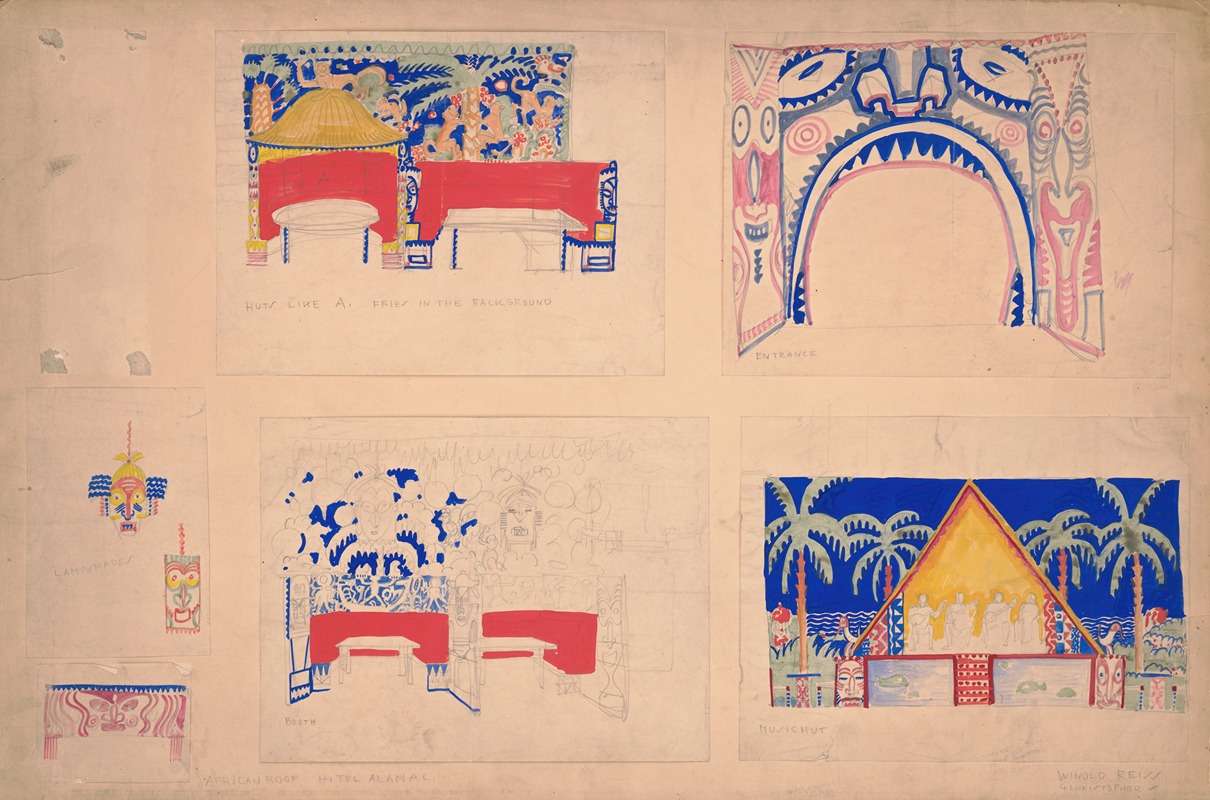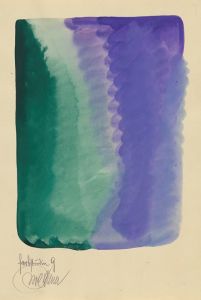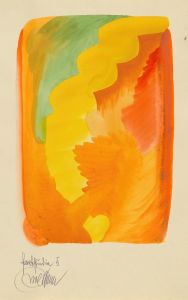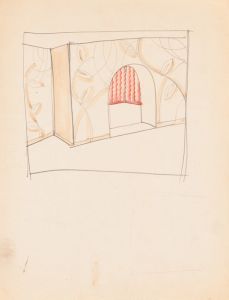
Designs for Alamac Hotel Congo Room, 71st and Broadway, New York, NY.] [Six color studies of interior, furniture, and murals
A hand-painted replica of Winold Reiss’s masterpiece Designs for Alamac Hotel Congo Room, 71st and Broadway, New York, NY.] [Six color studies of interior, furniture, and murals, meticulously crafted by professional artists to capture the true essence of the original. Each piece is created with museum-quality canvas and rare mineral pigments, carefully painted by experienced artists with delicate brushstrokes and rich, layered colors to perfectly recreate the texture of the original artwork. Unlike machine-printed reproductions, this hand-painted version brings the painting to life, infused with the artist’s emotions and skill in every stroke. Whether for personal collection or home decoration, it instantly elevates the artistic atmosphere of any space.
Winold Reiss was a German-born American artist and designer known for his contributions to interior design, particularly in the early to mid-20th century. One of his notable projects was the design work for the Alamac Hotel's Congo Room, located at 71st and Broadway in New York City. This project included six color studies focusing on the interior, furniture, and murals, showcasing Reiss's distinctive style and his ability to blend modernist aesthetics with vibrant color schemes.
Reiss immigrated to the United States in 1913 and quickly established himself as a versatile artist, working across various mediums including painting, graphic design, and interior decoration. His work often reflected a fusion of European modernism and American themes, which was evident in his designs for the Congo Room. The Alamac Hotel, during its time, was a prominent establishment, and the Congo Room was one of its key attractions, drawing visitors with its unique and colorful ambiance.
The color studies created by Reiss for the Congo Room were instrumental in defining the space's atmosphere. These studies were not merely preliminary sketches but were detailed plans that guided the execution of the room's final design. Reiss's approach to the Congo Room involved the use of bold colors and geometric patterns, which were characteristic of his work. His designs often included intricate murals that depicted scenes or abstract forms, adding a dynamic visual element to the interiors.
Reiss's work on the Congo Room is a testament to his skill in integrating art with architecture. His designs were not just decorative but were intended to enhance the overall experience of the space, creating an environment that was both aesthetically pleasing and functionally effective. The furniture designed for the Congo Room was likely custom-made to complement the murals and color schemes, ensuring a cohesive look throughout the space.
The murals in the Congo Room, as suggested by the color studies, would have been vibrant and possibly thematic, reflecting either cultural motifs or abstract designs that were popular in the era. Reiss was known for his ability to capture the essence of different cultures in his work, often drawing inspiration from Native American, African, and other indigenous art forms, although specific themes for the Congo Room murals are not detailed in available records.
Winold Reiss's contribution to the Alamac Hotel's Congo Room is an example of how art and design can transform a commercial space into an immersive experience. His work remains influential, reflecting a period in American design history where there was a strong emphasis on innovation and the blending of different artistic influences. While the Alamac Hotel itself no longer exists, Reiss's designs continue to be studied and appreciated for their artistic and historical significance.









![[Design drawing for Manhattan House Longchamps Restaurant, corner of 3rd Avenue and 65th Street, New York, NY.] [Study for mosaic front](/imgs/249260/s/winold-reiss-design-drawing-for-manhattan-house-longchamps-restaurant-corner-of-3rd-avenue-and-65th-street-new-york-ny-study-for-mosaic-front-441f1ed6.jpg)
![[Designs for roadhouse or terrace restaurant.] [Scheme [B] with a T-plan, 5- bays, with painted tulips in the pediments.](/imgs/249264/s/winold-reiss-designs-for-roadhouse-or-terrace-restaurant-scheme-b-with-a-tplan-5-bays-with-painted-tulips-in-the-pediments-ad771334.jpg)
![Design for Figures of Music Building, New York World’s Fair, 1939.] [Elevation detail](/imgs/249284/s/winold-reiss-design-for-figures-of-music-building-new-york-worlds-fair-1939-elevation-detail-b48f5853.jpg)
![Designs for Modern Hotel Suite, Du Pont Biltmore Hotel, Wilmington, Delaware.] Colour chart for Suite 210](/imgs/249317/s/winold-reiss-designs-for-modern-hotel-suite-du-pont-biltmore-hotel-wilmington-delaware-colour-chart-for-suite-210-70bfb090.jpg)
![Designs for theater with black-framed proscenium and boldly colored settings.] [Study for stage light wall decoration, possibly for Caf ̌Crillon ….](/imgs/249332/s/winold-reiss-designs-for-theater-with-blackframed-proscenium-and-boldly-colored-settings-study-for-stage-light-wall-decoration-possibly-for-caf-crillon--84fb4ba6.jpg)
![Interior design drawings for unidentified rooms.] [Sketch for unidentified room with starred walls](/imgs/249363/s/winold-reiss-interior-design-drawings-for-unidentified-rooms-sketch-for-unidentified-room-with-starred-walls-78931be1.jpg)
![Interior perspective drawings of Hotel Siwanoy, Mount Vernon, NY.] [Interior perspective study of Grill in yellow, blue, and green]](/imgs/249370/s/winold-reiss-interior-perspective-drawings-of-hotel-siwanoy-mount-vernon-ny-interior-perspective-study-of-grill-in-yellow-blue-and-green-bea2a60e.jpg)
![Interior perspective studies for Restaurant Crillon, 15 East 48th Street, New York, NY.] [Study for Le Passage or Pullman Room](/imgs/249378/s/winold-reiss-interior-perspective-studies-for-restaurant-crillon-15-east-48th-street-new-york-ny-study-for-le-passage-or-pullman-room-b703bb8b.jpg)
